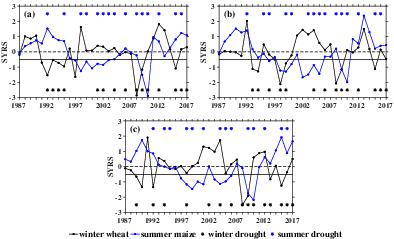当前位置:
X-MOL 学术
›
Meteorol. Appl.
›
论文详情
Our official English website, www.x-mol.net, welcomes your
feedback! (Note: you will need to create a separate account there.)
Assessment of drought impacts on crop yields across Nepal during 1987–2017
Meteorological Applications ( IF 2.3 ) Pub Date : 2020-09-30 , DOI: 10.1002/met.1950 Kalpana Hamal 1, 2 , Shankar Sharma 3 , Nitesh Khadka 2, 4 , Gebremedhin Gebremeskel Haile 2, 5, 6 , Bharat Badayar Joshi 7, 8 , Tianli Xu 8 , Binod Dawadi 3, 8
Meteorological Applications ( IF 2.3 ) Pub Date : 2020-09-30 , DOI: 10.1002/met.1950 Kalpana Hamal 1, 2 , Shankar Sharma 3 , Nitesh Khadka 2, 4 , Gebremedhin Gebremeskel Haile 2, 5, 6 , Bharat Badayar Joshi 7, 8 , Tianli Xu 8 , Binod Dawadi 3, 8
Affiliation

|
Drought influences agriculture, hydrology, ecology and socio‐economic systems globally. As agriculture is the primary source for livelihoods and contributes to ~27% of Nepalʼs total gross domestic product, it is essential to understand the impact of drought on maize and wheat crop yields to minimize the drought‐related risks. This study presents insights about agricultural drought across Nepal during 1987–2017 using the Standardized Precipitation Evapotranspiration Index (SPEI). The temporal evolution of SPEI time series has revealed frequent occurrences of drought episodes during the cropping cycle of summer maize and winter wheat crops. Moreover, the turning point of the drought was detected in 2000 (1987–2000, 2001–2017) in different regions. The averaged frequency for the SPEIs (1, 3, 6 and 12) of drought years for summer maize (winter wheat) in the western, central and eastern regions increased by 13% (12.5%), 6% (7.5%) and 7% (8%), respectively, from 1987–2000 to 2001–2017. The relationship between Standardized Yield Residual Series, the detrended SPEI at 1–12 lags and soil moisture was observed for both crops. The most correlated crop growth period for summer maize and winter wheat was the sowing and growing period, respectively, indicating the sensitive period of water deficit. Besides, the correlation performed in the two sub‐periods (1987–2000 and 2001–2017) shows that drought impacts increased in the western and central regions, whereas they substantially decreased in the eastern region during the cropping period of summer maize. However, the drought sensitivity for winter wheat was decreased in the western region but significantly increased in the central and eastern regions of Nepal. The results of this study provide important information useful for policymakers in monitoring and mitigating the drought‐related risks on maize and wheat crops in Nepal.
中文翻译:

评估1987-2017年间干旱对尼泊尔全国农作物产量的影响
干旱影响着全球的农业,水文学,生态学和社会经济系统。由于农业是生计的主要来源,约占尼泊尔国内生产总值的27%,因此必须了解干旱对玉米和小麦作物单产的影响,以最大程度地减少与干旱有关的风险。本研究使用标准化降水蒸散指数(SPEI)提供了有关1987-2017年尼泊尔农业干旱的见解。SPEI时间序列的时间演变表明,夏季玉米和冬小麦作物的种植周期中经常发生干旱。此外,在2000年(1987–2000年,2001–2017年)的不同地区发现了干旱的转折点。SPEI的平均频率(1、3,与1987年相比,西部,中部和东部地区夏季玉米(冬小麦)的干旱年数分别为6和12)分别增加了13%(12.5%),6%(7.5%)和7%(8%)。 2000至2001–2017。两种作物都观测到标准化单产残差序列,1–12滞后趋势下降的SPEI与土壤水分之间的关系。夏玉米和冬小麦最相关的作物生长期分别是播种期和生育期,这表明缺水敏感期。此外,在两个子时期(1987-2000年和2001-2017年)进行的相关分析表明,在夏玉米种植期间,干旱影响在西部和中部地区增加,而在东部地区则大大减少。然而,尼泊尔西部地区对冬小麦的干旱敏感性降低,但尼泊尔中部和东部地区显着提高。这项研究的结果为决策者监测和减轻尼泊尔玉米和小麦作物干旱相关风险提供了重要信息。
更新日期:2020-09-30
中文翻译:

评估1987-2017年间干旱对尼泊尔全国农作物产量的影响
干旱影响着全球的农业,水文学,生态学和社会经济系统。由于农业是生计的主要来源,约占尼泊尔国内生产总值的27%,因此必须了解干旱对玉米和小麦作物单产的影响,以最大程度地减少与干旱有关的风险。本研究使用标准化降水蒸散指数(SPEI)提供了有关1987-2017年尼泊尔农业干旱的见解。SPEI时间序列的时间演变表明,夏季玉米和冬小麦作物的种植周期中经常发生干旱。此外,在2000年(1987–2000年,2001–2017年)的不同地区发现了干旱的转折点。SPEI的平均频率(1、3,与1987年相比,西部,中部和东部地区夏季玉米(冬小麦)的干旱年数分别为6和12)分别增加了13%(12.5%),6%(7.5%)和7%(8%)。 2000至2001–2017。两种作物都观测到标准化单产残差序列,1–12滞后趋势下降的SPEI与土壤水分之间的关系。夏玉米和冬小麦最相关的作物生长期分别是播种期和生育期,这表明缺水敏感期。此外,在两个子时期(1987-2000年和2001-2017年)进行的相关分析表明,在夏玉米种植期间,干旱影响在西部和中部地区增加,而在东部地区则大大减少。然而,尼泊尔西部地区对冬小麦的干旱敏感性降低,但尼泊尔中部和东部地区显着提高。这项研究的结果为决策者监测和减轻尼泊尔玉米和小麦作物干旱相关风险提供了重要信息。











































 京公网安备 11010802027423号
京公网安备 11010802027423号